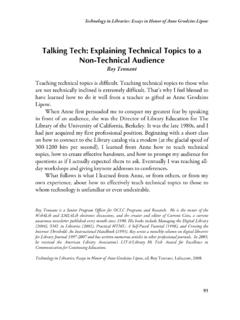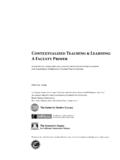Transcription of Topic guide 13.1: Factors affecting the location of a ...
1 Unit 13: Industrial chemistry . 13 1. Factors affecting the location of a chemical plant The chemical industry has existed as a major component of the UK. manufacturing sector for nearly 200 years. It continues to be a major part today, with an annual turnover of over 60 billion and employing 600 000. workers. In this Topic guide , you will look at the general principles that determine a suitable location for a chemical plant physical, human, environmental and economic and apply these principles to several case studies and to a plant familiar to you or within your locality. On successful completion of this Topic you will: understand Factors affecting the location of a chemical plant (LO1).
2 To achieve a Pass in this unit you need to show that you can: explain how Factors influence the choice of location ( ). assess the relevance of transportation costs and explain the importance of available resources ( ). review the effect of an environmental audit on the planning process ( ). explain the relevance of socio-economic issues ( ). 1. Unit 13: Industrial chemistry 1 location Factors The distribution of chemical plants across the country is far from even, with many plants clustered in regions where the industry has always been strong, for example, Scotland and the north of England.
3 The reasons these locations are favoured remain broadly similar to those that first gave rise to the industry in these areas access to ports, large-scale labour force and availability of raw materials. Across the country new manufacturing facilities are still being created, although now decisions about location are driven by access to imported crude oil, availability of a workforce with specialised skills and government grants for use of brownfield sites. Traditionally, many of the heavy chemical manufacturing plants in the north of England and Scotland have been located near ports. Examples include the petrochemical works at Grangemouth on the Firth of Forth near Edinburgh and the Runcorn cluster of industries close to the port of Liverpool, as well as those based in Teeside and the Humber estuary.
4 The locations of these are shown in Figure The significance of the port location for importation of raw materials and exportation of products will be discussed later in this section, but for a site to be suitable for any kind of chemical plant, it must fulfil a number of criteria that are inherent to that specific location . Figure : Much of the UK's chemical industry is clustered in four key regions. Grangemouth Teeside Humber estuary Runcorn : Factors affecting the location of a chemical plant 2. Unit 13: Industrial chemistry Take it further UK Trade & Investment (UKTI), a government organisation that helps businesses develop their markets, published a helpful and accessible report on the UK chemical industry in 2009 (available at ).
5 This is an excellent source of background information about the chemical industry, as well as providing useful case studies of a number of new and developing aspects of the industry. Activity To enable you to complete the activities in these Topic guides, you will need to select a particular chemical process to research. Your tutor will be able to advise you on your choice, but it should be a process with which you are familiar and for which you have access to information and data. Your place of employment may provide a suitable example, or it may be better to investigate a process in a local company that is willing to allow you to make contact with suitable employees to help you access the type of information you need.
6 If you do this, it will be important to try to arrange a site visit to the relevant company. As you work through the Topic guides, you will find that some of the activities ask you to find out specific information about your chosen process. At the end of each section of the guide , there are instructions to enable you to produce the portfolio evidence you will need to meet the assessment criteria. Select a particular process to research and discuss it with your tutor. Arrange a site visit if necessary. Geological Factors Many of the sites associated with the chemical industry have in the past been associated with large amounts of highly toxic waste materials, for example: heavy metals tailings from extraction of metals from ores sludges containing organic residues from oil refining.
7 The modern chemical industry in the UK now minimises the production and environmental impact of these residues, but in the past these residues may have been contained on site for long periods of time. The risk of leakage and contamination of surrounding soil was very significant, and the fate of the toxic materials depended largely on the underlying geology. The key geological feature of a site concerns the hydrogeology (movement of water through rocks: soil particles can adsorb metal or organic contaminants this is enhanced by the presence of organic matter or clay content in soils.)
8 Sandy or gravel-based soils allow more mobility of contaminants high density hydrocarbons that meet groundwater will sink through it until they meet an impermeable layer; at this point they will spread out low density hydrocarbons will float on top of groundwater. Drainage Chemical plants often occupy large flat sites as it is clear that building on hilly terrain will add additional construction costs to the building process. Such sites are likely to be found on flood plains or coastal sites and therefore may be prone to flooding. This has potentially disastrous implications for damage to the chemical : Factors affecting the location of a chemical plant 3.
9 Unit 13: Industrial chemistry plant and the spreading of contaminants through the soil and into water courses. Good drainage is therefore essential; unfortunately the clay-based soils that restrict mobility of contaminants drain poorly. Sites built on such soils may need additional drainage. In any case, flood defences may well be necessary for coastal or flood-plain sites. Activity For your chosen site, find out the underlying soil type clay, gravel, sand or other type (for example, sedimentary rock). What implications does this have for the dispersion of metal or organic contaminants?
10 Geographical Factors Greenfield and brownfield sites If a chemical plant is to be built in a new location then the land on which it will be Key terms built is likely to fall into the category of either a greenfield site or brownfield site. Greenfield site: Land that has Planning regulations encourage the use of brownfield sites and discourage not previously been developed the use of greenfield sites; there may be subsidies available for developing (for industrial or commercial brownfield sites. use). It can include land that has been developed, for example, for Brownfield sites may be of sizes or shapes that do not lend themselves to the agricultural use.

















